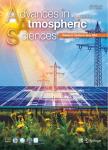Prediction of the Asian-Australian Monsoon Interannual Variations with the Grid-Point Atmospheric Model of IAP LASG(GAMIL)
Prediction of the Asian-Australian Monsoon Interannual Variations with the Grid-Point Atmospheric Model of IAP LASG(GAMIL)作者机构:State Key Laboratory of Numerical Modeling for Atmospheric Sciences and Geophysical Fluid Dynamics(LASG)Institute of Atmospheric Physics(IAP) State Key Laboratory of Numerical Modeling for Atmospheric Sciences and Geophysical Fluid Dynamics(LASG)Institute of Atmospheric Physics(IAP)Chinese Academy of Sciences100029
出 版 物:《Advances in Atmospheric Sciences》 (大气科学进展(英文版))
年 卷 期:2008年第25卷第3期
页 面:387-394页
核心收录:
学科分类:07[理学] 070601[理学-气象学] 0706[理学-大气科学]
基 金:the support of the National Natural Science Foundation of China(Grant Nos.40523001 and 40605022) the Chinese Acadiemy of the International Partnership Creative Group entitled"Climate System Model Development and Application Studies"
主 题:Asian-Australian monsoon interannual variation ENSO atmospheric general circulation model GAMIL
摘 要:Seasonal prediction of Asian-Australian monsoon (A-AM) precipitation is one of the most important and challenging tasks in climate prediction. In this paper, we evaluate the performance of Grid Atmospheric Model of IAP LASG (GAMIL) on retrospective prediction of the A-AM interannual variation (IAV), and determine to what extent GAMIL can capture the two major observed modes of A-AM rainfall IAV for the period 1979-2003. The first mode is associated with the turnabout of warming (cooling) in the Nifio 3.4 region, whereas the second mode leads the warming/cooling by about one year, signaling precursory conditions for ENSO. We show that the GAMIL one-month lead prediction of the seasonal precipitation anomalies is primarily able to capture major features of the two observed leading modes of the IAV, with the first mode better predicted than the second. It also depicts the relationship between the first mode and ENSO rather well. On the other hand, the GAMIL has deficiencies in capturing the relationship between the second mode and ENSO. We conclude: (1) successful reproduction of the E1 Nifio-excited monsoon-ocean interaction and E1 Nifio forcing may be critical for the seasonal prediction of the A-AM rainfall IAV with the GAMIL; (2) more efforts are needed to improve the simulation not only in the Nifio 3.4 region but also in the joining area of Asia and the Indian-Pacific Ocean; (3) the selection of a one-tier system may improve the ultimate prediction of the A-AM rainfall IAV. These results offer some references for improvement of the GAMIL and associated seasonal prediction skill.



